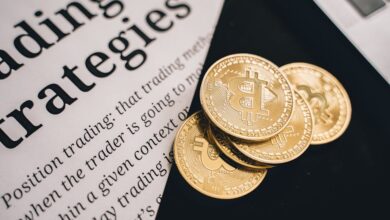Navigating Gold Investment: A Comprehensive Guide to Bullion, Coins, ETFs, and Mining Stocks in Today’s Market

In an ever-evolving financial landscape, gold investment remains a time-tested strategy for diversifying portfolios and safeguarding wealth. Whether through tangible assets like gold bullion and coins or more modern approaches such as gold ETFs and mining stocks, investors have a myriad of options at their disposal. As global economic uncertainties rise and inflation concerns intensify, understanding the nuances of the gold market becomes crucial. This article delves into the various forms of gold investment, including the allure of physical gold and the growing popularity of gold collectibles, while also examining market trends that influence gold prices. Furthermore, we will explore the future of gold, touching on sustainable gold mining practices, the geopolitical factors impacting gold trade, and the increasing recognition of gold as a safe haven asset in times of crisis. Join us as we navigate the multifaceted world of gold investment, uncovering insights that can empower informed decision-making in your financial journey.
- 1. Understanding Gold Investment: Exploring Gold Bullion, Coins, and ETFs
- 2. Analyzing Gold Market Trends: How Gold Prices and Inflation Impact Investment Choices
- 3. The Future of Gold: Gold Mining, Sustainable Practices, and the Rise of Gold as a Safe Haven Asset
1. Understanding Gold Investment: Exploring Gold Bullion, Coins, and ETFs
Gold investment has long been regarded as a reliable strategy for preserving wealth and safeguarding against economic uncertainty. Understanding the different forms of gold investments can help investors make informed decisions that align with their financial goals. Among the most popular options are gold bullion, coins, and gold ETFs.
Gold bullion refers to physical gold in the form of bars or ingots, which are often traded based on their weight and purity. This form of gold investment is favored by those who prioritize tangible assets, as it offers a direct hedge against inflation and economic instability. Investors often look at gold prices and market trends to time their purchases, aiming to acquire bullion when prices are favorable.
Gold coins are another tangible investment option, combining beauty with value. Collectible coins, such as the American Gold Eagle or the Canadian Maple Leaf, not only hold intrinsic value as gold but also appeal to collectors, adding an additional layer of investment potential. The rarity and historical significance of certain gold coins can significantly influence their market demand and prices.
For those who prefer a more liquid investment, gold ETFs (Exchange-Traded Funds) provide exposure to gold without the need for physical ownership. Gold ETFs track the price of gold and can be easily bought or sold on stock exchanges. This option is particularly attractive for investors looking to diversify their portfolios without the complexities of managing physical gold. Gold ETFs allow investors to leverage gold market analysis while avoiding the challenges associated with gold storage and security.
As global gold demand continues to rise, driven by concerns over inflation and economic instability, understanding these investment options is crucial. Investors should also be aware of the implications of gold recycling, gold production, and sustainable gold mining practices, which play significant roles in the gold market. Moreover, with the increasing interest in gold and cryptocurrency, understanding the dynamics of the gold trade in relation to digital currencies can provide further insights into investment strategies.
In conclusion, whether investing in gold bullion, coins, or ETFs, having a comprehensive understanding of the gold market trends and the factors influencing gold prices can help investors make strategic decisions that enhance their portfolios. With central banks accumulating gold reserves and the ongoing discussion around gold as a safe haven asset, now is an opportune time to explore the various avenues of gold investment.
2. Analyzing Gold Market Trends: How Gold Prices and Inflation Impact Investment Choices
Understanding gold market trends is essential for making informed investment choices in the ever-evolving landscape of gold investment. As a safe haven asset, gold often serves as a hedge against inflation and economic uncertainty. The relationship between gold prices and inflation is particularly significant; when inflation rises, the purchasing power of currency typically declines, which can lead investors to turn to gold. This trend reflects the historical view of gold as a store of value, especially during periods of heightened economic stress.
Gold prices are influenced by a myriad of factors, including global gold demand, central banks' gold reserves, and geopolitical tensions. For instance, when central banks increase their gold reserves, it often signals confidence in the asset's long-term value, which can drive up prices. Conversely, when gold production rises due to advancements in gold technology and sustainable gold mining practices, it may lead to a decrease in prices if supply outpaces demand.
Inflationary environments also impact the attractiveness of gold ETFs and gold futures. As inflation rises, these financial instruments can provide a more accessible way for investors to gain exposure to gold without needing to purchase physical gold, such as gold bars or coins. However, investors must be cautious of gold smuggling and the implications it has on the gold trade, as illicit activities can distort market trends and influence prices.
Additionally, the rise of cryptocurrencies has introduced a new dynamic into the gold market analysis. Some investors view digital currencies as competitors to gold, while others see them as complementary assets. This evolving relationship between gold and cryptocurrency can influence investment strategies, especially among younger investors who are increasingly interested in diversifying their portfolios with both gold collectibles and digital assets.
In summary, analyzing gold market trends requires a comprehensive understanding of how gold prices react to inflation, global demand, and technological advancements in gold mining and refining. By keeping an eye on these factors, investors can make more strategic decisions when investing in gold bullion, coins, or mining stocks, ultimately positioning themselves to benefit from the potential gains of this timeless investment.
3. The Future of Gold: Gold Mining, Sustainable Practices, and the Rise of Gold as a Safe Haven Asset
As we look towards the future of gold, several key factors are shaping its role in the global financial landscape. Gold has long been regarded as a safe haven asset, especially during times of economic uncertainty and inflation. With increasing geopolitical tensions and fluctuating economic conditions, the demand for gold continues to rise. Investors are seeking stability in gold investments, which include physical gold like bullion and coins, as well as gold ETFs that offer more accessible options for those who prefer not to handle the physical metal.
Gold mining practices are evolving, with a growing emphasis on sustainability. The gold mining industry has faced scrutiny over environmental impacts, leading to a push for sustainable gold mining practices. This includes responsible sourcing and reducing the ecological footprint of mining operations. Companies are adopting innovative technologies to enhance gold production while minimizing harm to the environment. Sustainable practices not only cater to ethical concerns but also appeal to a growing segment of investors who prioritize environmental, social, and governance (ESG) factors in their investment decisions.
In addition to ethical considerations, gold's value as a long-term investment is bolstered by its historical performance during inflationary periods. The relationship between gold and inflation is well-documented, making gold a preferred choice for preserving wealth. Central banks around the world are also increasing their gold reserves, which further indicates confidence in gold as a hedge against economic instability. The continuous rise in global gold demand, coupled with limited gold production, suggests that gold prices may see upward pressure in the coming years.
Moreover, the gold market is witnessing a dynamic interplay with other investment vehicles, particularly cryptocurrency. As digital currencies gain popularity, discussions about gold and cryptocurrency as complementary assets are becoming common. While cryptocurrencies offer high volatility and potential for significant returns, gold provides a sense of stability and security. This unique positioning may lead to increased interest in gold collectibles, jewelry, and other forms of gold investment.
Overall, the future of gold investment looks promising, with increasing global demand, sustainable practices in gold mining, and its established reputation as a safe haven asset. Investors are likely to continue exploring various avenues, from gold bars and bullion to gold futures and mining stocks, to diversify their portfolios and mitigate risks associated with economic fluctuations.
References:
– World Gold Council. (2023). Gold Demand Trends. Retrieved from [https://www.gold.org](https://www.gold.org)
– International Council on Mining and Metals (ICMM). (2023). Mining and Sustainable Development. Retrieved from [https://www.icmm.com](https://www.icmm.com)
– Financial Times. (2023). The Rise of Gold as a Hedge against Inflation. Retrieved from [https://www.ft.com](https://www.ft.com)
In conclusion, gold investment remains a compelling option for diversifying portfolios and safeguarding wealth, especially in the face of economic uncertainty. Whether you choose to invest in physical gold, such as bullion and coins, or opt for more modern approaches like gold ETFs and mining stocks, understanding the nuances of the gold market is crucial. As we’ve explored, factors like inflation and global gold demand significantly influence gold prices and investment strategies, making it essential to stay informed about market trends and economic indicators.
The future of gold is equally fascinating, with advancements in sustainable gold mining practices and a growing recognition of gold as a safe haven asset amid market volatility. Central banks continue to bolster their gold reserves, further legitimizing gold’s status in today’s financial landscape. Moreover, the emergence of gold technology and the potential for gold futures to complement traditional investments present exciting opportunities for savvy investors.
As the landscape of gold investment evolves, staying abreast of gold market analysis and trends will empower you to make informed decisions. Whether you are drawn to luxury gold collectibles, the stability of gold bars, or the innovative aspects of gold recycling, the options are diverse and promising. Ultimately, gold investment not only serves as a hedge against inflation but also as a means to participate in the timeless allure of this precious metal. Embrace the potential of gold and position yourself strategically in the ever-evolving gold trade.
References:
[Include relevant citations here]




